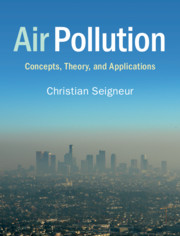Book contents
- Air Pollution
- Air Pollution
- Copyright page
- Contents
- Preface
- Main Notations
- 1 Brief History of Air Pollution
- 2 Emissions of Air Pollutants and Emission Control Technologies
- 3 Meteorology: General Circulation
- 4 Air Pollution Meteorology
- 5 Atmospheric Radiative Transfer and Visibility
- 6 Atmospheric Dispersion
- 7 The Stratospheric Ozone Layer
- 8 Gaseous Pollutants
- 9 Atmospheric Particles
- 10 Clouds and Acid Rain
- 11 Transfer of Pollutants between the Atmosphere and Surfaces
- 12 Health Effects
- 13 Environmental Impacts
- 14 Climate Change and Air Pollution
- 15 Regulations and Public Policies
- Index
- References
1 - Brief History of Air Pollution
Published online by Cambridge University Press: 19 June 2019
- Air Pollution
- Air Pollution
- Copyright page
- Contents
- Preface
- Main Notations
- 1 Brief History of Air Pollution
- 2 Emissions of Air Pollutants and Emission Control Technologies
- 3 Meteorology: General Circulation
- 4 Air Pollution Meteorology
- 5 Atmospheric Radiative Transfer and Visibility
- 6 Atmospheric Dispersion
- 7 The Stratospheric Ozone Layer
- 8 Gaseous Pollutants
- 9 Atmospheric Particles
- 10 Clouds and Acid Rain
- 11 Transfer of Pollutants between the Atmosphere and Surfaces
- 12 Health Effects
- 13 Environmental Impacts
- 14 Climate Change and Air Pollution
- 15 Regulations and Public Policies
- Index
- References
Summary
The Earth’s atmosphere is composed mostly of molecular nitrogen (N2, 78 % of dry air) and molecular oxygen (O2, 21 % of dry air). It holds also a fair amount of water vapor (H2O), which varies greatly in concentration (ranging from negligible in dry regions to a few % in humid regions) and leads to the formation of clouds and fogs in case of supersaturation. The Earth’s atmosphere also contains carbon dioxide (CO2), which has an average concentration of about 0.04 %. H2O and CO2 are gases that absorb infrared (IR) radiation, but let ultraviolet (UV) and visible solar radiation go through. Since they partially absorb IR radiation emitted by the Earth toward space, these species are called “greenhouse gases” (GHG).
- Type
- Chapter
- Information
- Air PollutionConcepts, Theory, and Applications, pp. 1 - 5Publisher: Cambridge University PressPrint publication year: 2019



